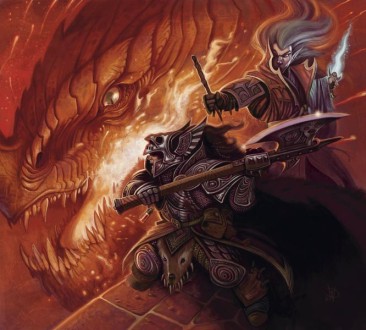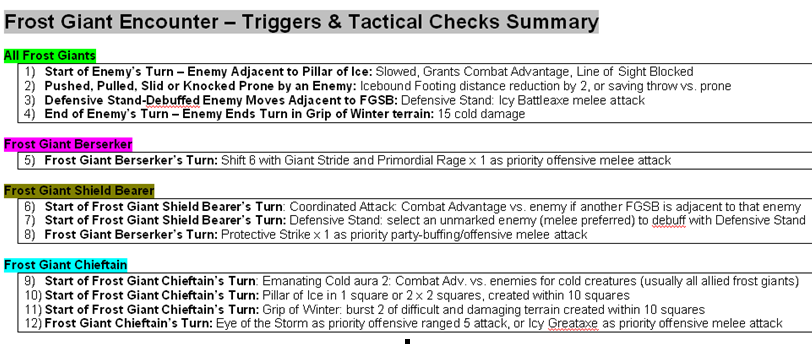
![]() Wish you had less to track during D&D 4e combat encounters, especially as a DM? Or as a player?
Wish you had less to track during D&D 4e combat encounters, especially as a DM? Or as a player?
Do you wonder why the typical 4e combat often moves so slowly from turn to turn, and if there is a better approach or tool – through a bird’s eye, whole encounter level view – to track all of its phases, triggers and Not So Immediate Actions? You’ve come to the right place!
The Problem: Trigger Overload
The main issue with 4e combat that contributes to slowdown is there’s far too many phases, tactical checkpoints, or triggers, if you will, to keep track of and execute.
In an actual encounter, with multiple monsters and multiple PCs, that’s really where the heart of the slowdown is. And I’m not even talking about the three actions minimum every creature and character gets on their turn! That’s potentially at least three significant tactical decisions on your turn and every single turn, as my brother so insightfully pointed out when we were talking about 4e combat length and slowdown the other day.
There needs to be a balance of “cool powers” for groups of monsters that aren’t an execution nightmare or timesink in actual gameplay, similar to the slog that characters’ immediate actions and triggers can bring collectively to combat pacing.
I find that’s what makes running some encounters so difficult as a DM – too many phases, tactical checkpoints, or triggers to pay attention to. And when you do track all them, you can create some major slowdown, contributing even further to the overlong 60 minute combat.
Simple Solution: Damage Substitution
These days, like with my PCs when I play, when I DM I look for monsters who don’t have so many “phases” to keep track of, collectively, in an encounter.
Auras, free actions and even “no actions” add up too – they’re nearly all triggers of some kind as well, so make sure to take those into account when you look over a monster stat block or all of a PC’s class features, feats and powers. Simpler is just better here, as the main thing you’re looking for is saving time and sanity during combat.
You can find details and suggested damage values for this simple approach in Monster Complexity and Selection. Replacing triggered powers or similar abilities with bonus damage applied to on-turn attacks is a very fast and simple option to help fight back trigger and phase overload.
Deeper Solution: Encounter Triggers Checklist
Sometimes, however, simpler monsters that have very few or zero triggered actions or multiple tactical check-ins isn’t the answer. For example, like in my recent medusae encounter experience, you have a cool thematic encounter in mind, filled with monster variety and shaped by engaging lore and story connections. So if you just go with the simple solution, you end up limiting the pool of monsters to choose from.
And with the creative alchemy of encounter building as something that’s supposed to be enjoyable for the DM, only having the choice of a few mechanically simpler monsters is obviously not ideal. To this end, and to actually be able to run high frequency phase or tactical checkpoint encounters, I have begun experimenting with an expansion of the Monster Tactics section you see in most monster entries not found in Monster Vault: encounter tactics, or more specifically, encounter triggers checklists, inspired by what you’d find in published adventures or sourcebooks like Dungeon Delve.
The reality is, DM’s need encounter tactics more than individual monster tactics. In actual play, you’re almost always running groups of monsters. On top of that, the suggested powers or combinations in many tactics sections just aren’t enough. You also need some sort of phase or trigger tracker to really help make the encounter run smoothly and save you time and sanity.
Here’s an example encounter triggers checklist. Unlike published material encounter tactics summaries, it’s not written in prose. Instead, the focus is a streamlined, tactical, combat phase-based dashboard or check list-style presentation. This approach improves readability, efficiency and thus usability of all the monsters’ tactics. This particular example is based on a late paragon tier frost giant encounter, including one chieftain and multiples of the others:
As you can see, all the monster-related phases or tactical checkpoints of this entire, specific encounter – on everyone’s turn, PC or monster – are listed. These check-ins are important as they key off monster auras, immediate actions and other triggered or specially timed abilities. Both primary offensive options or combinations are listed for each monster as well. In essence, this is a more visual and timing-based evolution or alternative to existing published prose-style encounter tactical summaries.
With these efficient encounter trigger checklists or scripts, a DM can more confidently, accurately and smoothly bring to bear all the tactical might and brilliance of each monster, as was intended. After all, these triggers are part of the reason that monster is the level it is – forgetting or omitting all those triggers seriously reduces the threat level of the monsters, ultimately making them a bore to both run or fight.
Your Solutions
What do you think of this encounter triggers checklist approach? Do you do something similar or how do you handle all the tactical checkpoints and triggered actions in your game, whether as a PC with just your character sheet to worry about, or as a DM with a whole slew of monsters to play?
More Faster Combat Tips
Looking for more advice for faster combat? You might also like Faster D&D 4e Combat: Top Tips, Monster Complexity and Selection, and Combat Mastery: Tactical Awareness & Teamwork 101.
Also, Matt Sernett’s Combat Velocity article on the D&D website this week includes several excellent suggestions to speed up combat, from roleplayed resolutions to doubling damage and more.

I might sort it a bit differently, by events and then actions rather then grouping them by monster. I would do something like:
start of PCs turn:
-Monster 1 aura
Attacks against Monsters:
-Monster 1 redirects attacks
-Monster 2 shifts on a miss
Bloodied:
-Monster 1’s main power recharges.
But thats just me.
Herrozerro recently posted..The Bright Beauty
Welcome to Leonine Roar and thanks for your comment, Herrozerro!
I also like your format – it covers all the phases of an encounter, but without every single tactical power or tactic’s shorthand I use in my triggers checklist. And it has the advantage of being faster to put together on the spot – very nice, thanks!
Thanks for the tip !
My group is finishing Tombs of Horrors (at half-way mark, 3 deaths, 2 sex changes..) and will be Lvl 11 at the end. Creatures are just getting more and more complicated, having multiple things to track, that i need to write these Trigger Sheets.
As an example, i forgot 2 rounds of regeneration for the False Acererak (good for them since a player might have died if he was up for one more round..)
Welcome to Leonine Roar and thanks for your comment, Francois!
It’s good to know you find this idea helpful – there’s no question the amount of things to track and check for only increases as character and monster levels increase as well. At some point, we need better tools – even if it’s just a simple encounter checklist or quick reference sheet – to help us remember, manage and resolve it all more smoothly.
Just a few nights ago, even as a player, I was relieved to have my Buff Cards in front of me for my 16th level Nentir Vale game. A mid-level paragon tier ranger and his allies can put together some glorious (yet ocassionally time-consuming and intricate) turns!
[…] Faster Combat: Encounter Triggers Checklist […]
[…] 11. Faster Combat: Encounter Triggers Checklist […]